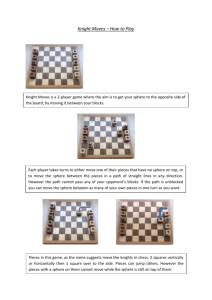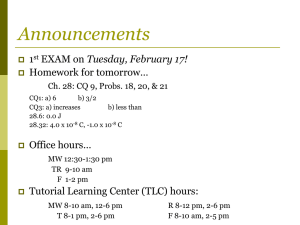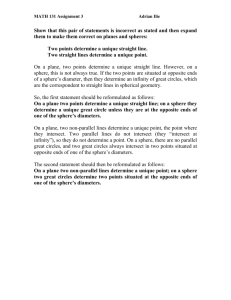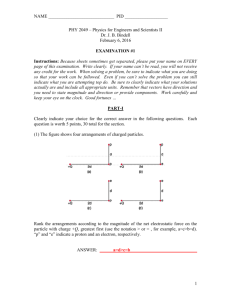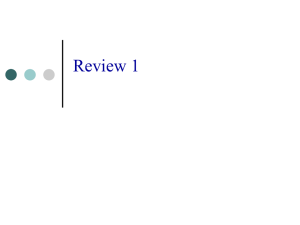A solid conducting sphere is given a positive charge Q. How is the
advertisement
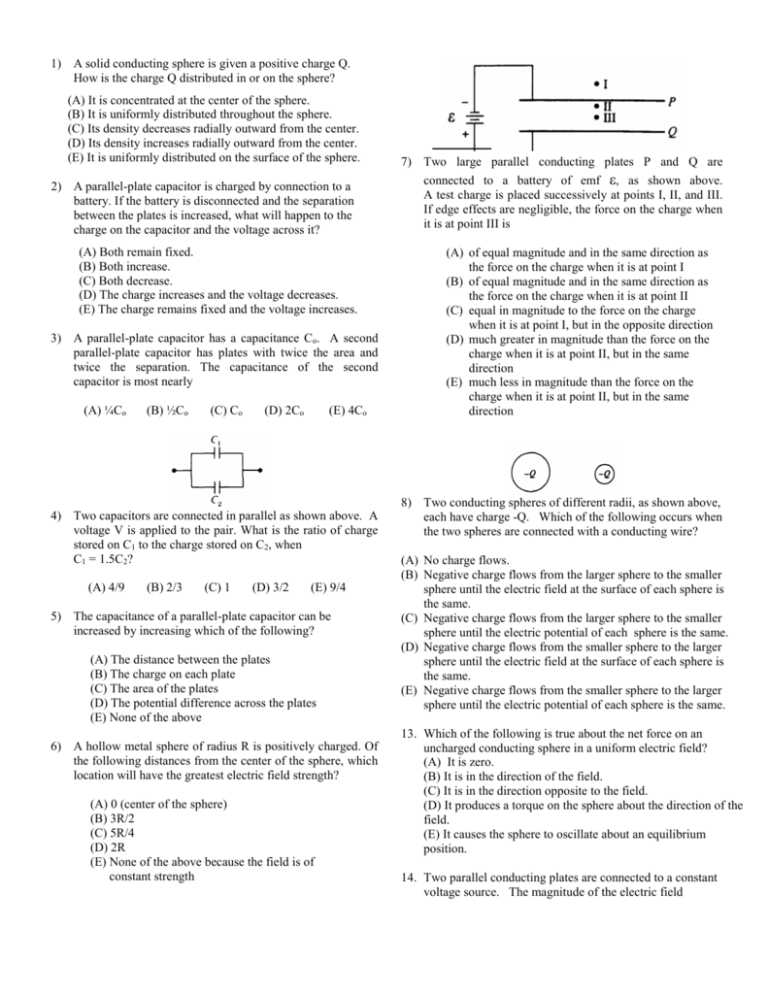
1) A solid conducting sphere is given a positive charge Q. How is the charge Q distributed in or on the sphere? (A) It is concentrated at the center of the sphere. (B) It is uniformly distributed throughout the sphere. (C) Its density decreases radially outward from the center. (D) Its density increases radially outward from the center. (E) It is uniformly distributed on the surface of the sphere. 2) A parallel-plate capacitor is charged by connection to a battery. If the battery is disconnected and the separation between the plates is increased, what will happen to the charge on the capacitor and the voltage across it? (A) Both remain fixed. (B) Both increase. (C) Both decrease. (D) The charge increases and the voltage decreases. (E) The charge remains fixed and the voltage increases. 3) A parallel-plate capacitor has a capacitance Co. A second parallel-plate capacitor has plates with twice the area and twice the separation. The capacitance of the second capacitor is most nearly (A) ¼Co (B) ½Co (C) Co (D) 2Co (E) 4Co 4) Two capacitors are connected in parallel as shown above. A voltage V is applied to the pair. What is the ratio of charge stored on C1 to the charge stored on C2, when C1 = 1.5C2? (A) 4/9 (B) 2/3 (C) 1 (D) 3/2 (E) 9/4 5) The capacitance of a parallel-plate capacitor can be increased by increasing which of the following? (A) The distance between the plates (B) The charge on each plate (C) The area of the plates (D) The potential difference across the plates (E) None of the above 6) A hollow metal sphere of radius R is positively charged. Of the following distances from the center of the sphere, which location will have the greatest electric field strength? (A) 0 (center of the sphere) (B) 3R/2 (C) 5R/4 (D) 2R (E) None of the above because the field is of constant strength 7) Two large parallel conducting plates P and Q are connected to a battery of emf , as shown above. A test charge is placed successively at points I, II, and III. If edge effects are negligible, the force on the charge when it is at point III is (A) of equal magnitude and in the same direction as the force on the charge when it is at point I (B) of equal magnitude and in the same direction as the force on the charge when it is at point II (C) equal in magnitude to the force on the charge when it is at point I, but in the opposite direction (D) much greater in magnitude than the force on the charge when it is at point II, but in the same direction (E) much less in magnitude than the force on the charge when it is at point II, but in the same direction 8) Two conducting spheres of different radii, as shown above, each have charge -Q. Which of the following occurs when the two spheres are connected with a conducting wire? (A) No charge flows. (B) Negative charge flows from the larger sphere to the smaller sphere until the electric field at the surface of each sphere is the same. (C) Negative charge flows from the larger sphere to the smaller sphere until the electric potential of each sphere is the same. (D) Negative charge flows from the smaller sphere to the larger sphere until the electric field at the surface of each sphere is the same. (E) Negative charge flows from the smaller sphere to the larger sphere until the electric potential of each sphere is the same. 13. Which of the following is true about the net force on an uncharged conducting sphere in a uniform electric field? (A) It is zero. (B) It is in the direction of the field. (C) It is in the direction opposite to the field. (D) It produces a torque on the sphere about the direction of the field. (E) It causes the sphere to oscillate about an equilibrium position. 14. Two parallel conducting plates are connected to a constant voltage source. The magnitude of the electric field between the plates is 2,000 N/C. If the voltage is doubled and the distance between the plates is reduced to 1/5 the original distance, the magnitude of the new electric field is (A) 800 N/C (B) 1,600 N/C (C) 2,400 N/C (D) 5,000 N/C (E) 20,000 N/C 64. Two parallel conducting plates, separated by a distance d, are connected to a battery of emf . Which of the following is correct if the plate separation is doubled while the battery remains connected? (A) The electric charge on the plates is doubled. (B) The electric charge on the plates is halved. (C) The potential difference between the plates is doubled. (D) The potential difference between the plates is halved (E) The capacitance is unchanged. 70. A 4 F capacitor is charged to a potential difference of 100 V. The electrical energy stored in the capacitor is (A) 2 x 10-10 J (B) 2 x 10-8 J (C) 2 x 10-6 J -4 -2 (D) 2x 10 J (E) 2 x 10 J Two large, flat, parallel, conducting plates are 0.04 m apart, as shown above. The lower plate is at a potential of 2 V with respect to ground. The upper plate is at a potential of 10 V with respect to ground. Point P is located 0.01 m above the lower plate. 45. The electric potential at point P is a. 10 V b. 8 V c. 6 V d. 4 V 46. The magnitude of the electric field at point P is a. 800V/m b. 600V/m c. 400 V/m d. 200 V/m e. 100 V/m 70. A hollow metal sphere 1.0 m in diameter carries a charge of 4.0 μC. The electric field at a distance of 2.0 m from the center of the sphere is most nearly a. 9.0 x 103 N/C b. 1.8 x 104 N/C c. 2.4 x 104 N/C 104 N/C e. 1.4 x 105 N/C 15. The hollow metal sphere shown above is positively charged. Point C is the center of the sphere and point P is any other point within the sphere. Which of the following is true of the electric field at these points? a. It is zero at both points. b. It is zero at C, but at P it is not zero and is directed inward. c. It is zero at C, but at P it is not zero and is directed outward. d. It is zero at P, but at C it is not zero. e. It is not zero at either point. e. 2 V d. 3.6 x

